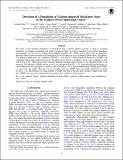Detection of a Population of Carbon-enhanced Metal-poor Stars in the Sculptor Dwarf Spheroidal Galaxy*
Author(s)
Simon, Joshua D.; Thompson, Ian B.; Shectman, Stephen A.; Mateo, Mario; Bailey, John I.; Crane, Jeffrey D.; Walker, Matthew; Frebel, Anna L.; Chiti, Anirudh; ... Show more Show less
DownloadChiti_2018_ApJ_856_142.pdf (2.111Mb)
PUBLISHER_POLICY
Publisher Policy
Article is made available in accordance with the publisher's policy and may be subject to US copyright law. Please refer to the publisher's site for terms of use.
Terms of use
Metadata
Show full item recordAbstract
The study of the chemical abundances of metal-poor stars in dwarf galaxies provides a venue to constrain paradigms of chemical enrichment and galaxy formation. Here we present metallicity and carbon abundance measurements of 100 stars in Sculptor from medium-resolution (R ∼ 2000) spectra taken with the Magellan/Michigan Fiber System mounted on the Magellan-Clay 6.5 m telescope at Las Campanas Observatory. We identify 24 extremely metal-poor star candidates ([Fe/H] < -3.0) and 21 carbon-enhanced metal-poor (CEMP) star candidates. Eight carbon-enhanced stars are classified with at least 2σ confidence, and five are confirmed as such with follow-up R ∼ 6000 observations using the Magellan Echellette Spectrograph on the Magellan-Baade 6.5 m telescope. We measure a CEMP fraction of 36% for stars below [Fe/H] = -3.0, indicating that the prevalence of carbon-enhanced stars in Sculptor is similar to that of the halo (∼43%) after excluding likely CEMP-s and CEMP-r/s stars from our sample. However, we do not detect that any CEMP stars are strongly enhanced in carbon ([C/Fe] > 1.0). The existence of a large number of CEMP stars both in the halo and in Sculptor suggests that some halo CEMP stars may have originated from accreted early analogs of dwarf galaxies.
Date issued
2018-04Department
Massachusetts Institute of Technology. Department of Physics; MIT Kavli Institute for Astrophysics and Space ResearchJournal
Astrophysical Journal
Publisher
American Astronomical Society
Citation
Chiti, Anirudh et al. “Detection of a Population of Carbon-Enhanced Metal-Poor Stars in the Sculptor Dwarf Spheroidal Galaxy.” The Astrophysical Journal 856, 2 (April 2018): 142 © 2018 The American Astronomical Society
Version: Final published version
ISSN
1538-4357
0004-637X